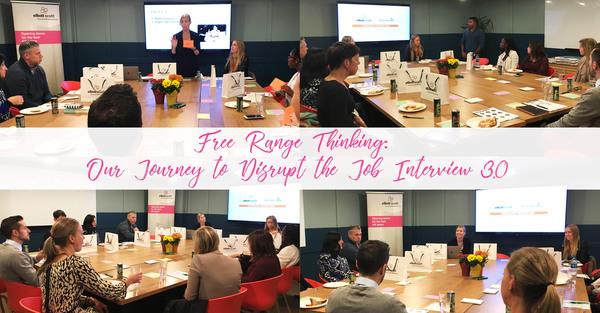Drop off your CV
We serve the global HR community through our offices located in Delhi, Hong Kong, London, New York, São Paulo and Singapore and have placed HR leaders in over 30 countries.
This guest post is written by Kristin Dudley, Chief Product Officer of Technical.ly, a local...

This guest post is written by Kristin Dudley, Chief Product Officer of Technical.ly, a localized Tech news publisher in the Mid-Atlantic region of the US.
The article originally appeared on Technical.ly.
Following their third event, this continues the journey of our New York office's experimental “Free Range Thinking” series in partnership with Technical.ly where HR professionals get together to "disrupt the job interview", creatively collaborating without boundaries. Read the previous write up's here and here.
The goal of a job interview is to capture some insight into a candidate, and in the best circumstances, to let that candidate peer more into an organization’s culture. Most job interviews today would look familiar to Thomas Edison, who is often considered among the first to systemize the process of interviewing and testing candidates. So it figures that hiring managers and HR professionals are working to update the form. It’s been a hundred years since Edison’s work in the field, after all. We at Technical.ly are working to contribute to the change. Partnering with Rosh Jayawardena, Director and specialty recruiter of HR professionals for Elliott Scott HR, we’ve been leading quarterly three-hour evening sessions with a cross-section of HR leaders — made all the more fun with my new role as Technical.ly Chief Product Officer. We call them Free Range Thinking Events.
In the last year, we’ve brought more than 40 different organizations together, like American Express, Facebook, Bloomberg, Nickelodeon and local innovation companies like O3 World. Accompanied by beer, pizza and colorful index cards, we’re generating ideas for updating the job interview for today’s needs and styles. At each event, we challenge attendees with the same problem statement: “Job interviews are poor indicators of future employee performance. How can we replace the job interview as the centerpiece of the hiring process?”. To kick off our most recent gathering last month, our attendees engaged with a game of Candidate Chemistry™, an experience I developed to better connect new and prospective hires to their hiring manager and team. We then introduced our special guest speaker, Alexis Smith, former Director of Employer Brand for beverage giant Anheuser-Busch. Alexis shares a great story in developing an ‘escape room’ experience for career fairs that gave individuals a crash-course in what it’s like to work for the company. From there, Alexis and I joined our guests to generate other ideas to approach job interviews differently.
News organization or not, the discussions are off-the-record, but the ideas are worth sharing. We not only shape ideas, we share our own best practices. At a recent event, several HR execs were split on the term “fit” to refer to hiring. One attendee criticized the term for essentially showing bias, as “fit” can be code for someone’s comfort or familiarity with a person. One of the greatest issues with interviews, and why we decided to focus on them for each of our events in 2018, is due to the presence of unconscious bias. Sean Yates, former VP of Recruitment for J.P. Morgan, shared how they built out their banking tech team in Japan by removing all detail from resumes and focusing purely on individual skills. They surprised themselves when they filled the 90% of the team with individuals that had no experience in the banking industry, something that would have been strongly considered previously.
In the Free Range Thinking sessions, we often find ourselves discussing how we can create a shared “test drive,” experience for candidates, similar to how we experience buying a car or trying a new SaaS product. Choosing a job is a huge commitment. What’s a version of “test drives” for the hiring process? At the event last month, Stacey Payne, Chief People Officer of Dig Inn, told us about a new service called Hoppin’ which sells job shadowing experiences to individuals interesting in exploring new careers. Would you pay to spend a week on the job? After three hours of hashing it out, the group settled on three big ideas to represent their cohort: The Blind Audition: anonymous and focused on the work a candidate has done, rather than their background. Ends with an in-person pitch. This solution would address unconscious bias. The good, the bad, the ugly – dedicated discussion that promises more transparency, rather than being a sales pitch back and forth. It would incorporate sharing real and present challenges or team dynamics that the new hire would have to prepare to navigate. Providing candidates with a menu of different types of interviews they can choose from – this would empower the candidate to take some control of the interview. The menu might include “panel interview” or “walk and talk interview” or even the “blind audition.” An agreed upon menu of styles agreed upon and known internally.
Thank you to our innovators from this session for your input and ideas: Esso Bodjona, Frieda Murphy, Gina Soloperto, Ann McGinley, Sean Yates, Catherine Gutierrez, Stacey Payne and Scott Leonardis.
We have one final event in our Free Range Thinking series focused on disrupting the job interview. In that event we’ll turn the tables and bring in the job candidates to gather their ideas for disrupting the job interview. What ideas do you have?